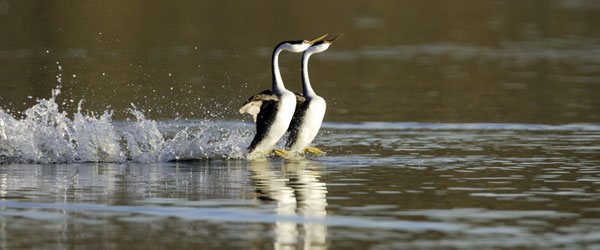How Do Animals Walk on Water?

More than 1,200 animal species have evolved the ability to walk on water. Tiny creatures such as insects and spiders can do it, and larger ones such as some reptiles, birds and even mammals have also developed this talent.
Though there are as many specialized techniques for walking on water as there are species that do it, water-walkers fall into two general categories slappers and gliders, according to a 2006 paper in the journal Annual Review of Fluid Mechanics.
Gliders
The tiniest animals are gliders. Insects, such as water striders, and spiders, such as fisher spiders, can glide or scamper across the surface of water. These critters are small enough that their weight can be supported almost entirely by surface tension, the relatively weak forces that hold water molecules together.
For these animals, gliding across the water is actually similar to how you might bounce on a trampoline, according to John Bush, a mathematician at the Massachusetts Institute of Technology, who specializes in fluid dynamics. When tiny water-walking insects or spiders press against the water, their feet bend or deform the surface, but don't break through it. The surface then bounces back, propelling the tiny water-walker forward.
Surface tension makes this type of locomotion possible. Water molecules adhere to other water molecules around them in all directions. And the molecules at the surface of a lake have no water molecules above them, so they tend to stick more strongly to their neighbors, forming a film-like layer across the surface, Bush said.
Water-repellent feet are required too. These animals have a microscopic layer of dense hairs on their legs that can be coated with water-repellent wax, or the hairs can trap a cushion of air around their legs. Without this adaptation, the water would soak right through their feet like they were sinking through the trampoline, Bush said.
Get the world’s most fascinating discoveries delivered straight to your inbox.
Slappers
Larger animals are slappers. Surface tension forces are too weak to support the weight of a larger body.
The basilisk lizard, water birds including the Western Grebe, and even some tail-walking dolphins must strike the surface with enough force and speed to keep their heavier bodies from going under.
The basilisk lizard, for instance, can dash at speeds of more than five feet per second by slapping the water with its hind feet. Its downward stroke pushes water away from its leg, creating a tiny air pocket around its foot, against which it pushes off. But the lizard must move its legs fast enough so the air pocket doesn't close around the foot, dragging it down into the water.
Smaller lizards can more easily generate the force needed to lift them out of the water, while larger ones must get a running start on land to achieve the momentum needed to support their weight and stay afloat.
Most animals travel only short distances on water. Some, such as the basilisk lizard, do it to evade land-bound predators, while others, like fisher spiders, to forage for food. Still others do it as part of an elaborate mating ritual, such the Western Grebe.
Water striders are among of the very few species that spend nearly their entire lifecycle at the water's surface.


